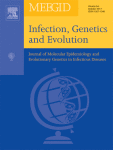Ver ítem
- xmlui.general.dspace_homeCentros e Institutos de InvestigaciónCICVyA. Centro de Investigación en Ciencias Veterinarias y AgronómicasInstituto de Microbiología y Zoología AgrícolaArtículos científicosxmlui.ArtifactBrowser.ItemViewer.trail
- Inicio
- Centros e Institutos de Investigación
- CICVyA. Centro de Investigación en Ciencias Veterinarias y Agronómicas
- Instituto de Microbiología y Zoología Agrícola
- Artículos científicos
- Ver ítem
Genomic diversity in a population of Spodoptera frugiperda nucleopolyhedrovirus
Resumen
Spodoptera frugiperda multiple nucleopolyhedrovirus (SfMNPV) represents a strong candidate to develop environmental-friendly pesticides against the fall armyworm (Spodoptera frugiperda), a widespread pest that poses a severe threat to different crops around the world. To date, SfMNPV genomic diversity of different isolates has been mainly studied by means of restriction pattern analyses and by sequencing of the egt region. Here, the genomic diversity
[ver mas...]
Spodoptera frugiperda multiple nucleopolyhedrovirus (SfMNPV) represents a strong candidate to develop environmental-friendly pesticides against the fall armyworm (Spodoptera frugiperda), a widespread pest that poses a severe threat to different crops around the world. To date, SfMNPV genomic diversity of different isolates has been mainly studied by means of restriction pattern analyses and by sequencing of the egt region. Here, the genomic diversity present inside an isolate of SfMNPV was explored using high-throughput sequencing for the first time. We identified 704 intrahost single nucleotide variants, from which 184 are nonsynonymous mutations distributed among 82 different coding sequences. We detected several structural variants affecting SfMNPV genome, including two previously reported deletions inside the egt region. A comparative analysis between polymorphisms present in different SfMNPV isolates and our intraisolate diversity data suggests that coding regions with higher genetic diversity are associated with oral infectivity or unknown functions. In this context, through molecular evolution studies we provide evidence of diversifying selection acting on sf29, a putative collagenase which could contribute to the oral infectivity of SfMNPV. Overall, our results contribute to deepen our understanding of the coevolution between SfMNPV and the fall armyworm and will be useful to improve the applicability of this virus as a biological control agent.
[Cerrar]

Autor
Masson, Tomás;
Fabre, María Laura;
Pidre, Matias Luis;
Niz, José María;
Berretta, Marcelo Facundo;
Romanowski, Víctor;
Ferrelli, María Leticia;
Fuente
Infection, Genetics and Evolution 90 : 104749 (junio 2021)
Fecha
2021-06
Editorial
Elsevier
Formato
pdf
Tipo de documento
artículo
Palabras Claves
Derechos de acceso
Restringido
 Excepto donde se diga explicitamente, este item se publica bajo la siguiente descripción: Creative Commons Attribution-NonCommercial-ShareAlike 2.5 Unported (CC BY-NC-SA 2.5)
Excepto donde se diga explicitamente, este item se publica bajo la siguiente descripción: Creative Commons Attribution-NonCommercial-ShareAlike 2.5 Unported (CC BY-NC-SA 2.5)

